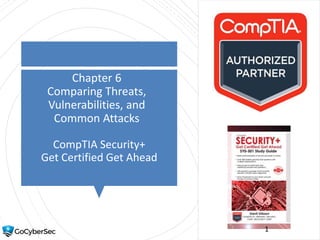
501 ch 6 threats vulnerabilities attacks
- 1. Chapter 6 Comparing Threats, Vulnerabilities, and Common Attacks CompTIA Security+ Get Certified Get Ahead 1
- 2. Introduction • Understanding threat actors • Determining malware types • Recognizing common attacks • Blocking malware and other attacks • Educating users
- 3. Threat Actors • Open-source intelligence – Info freely available (such as from web sites and social media) • Script kiddie – Little expertise, sophistication, or funding • Hacktivist – Part of an activist movement • Insider – Employee (can become a malicious insider) • Organized crime – Typically motivated by money • Competitor
- 4. Threat Actors • Nation state/advanced persistent threat (APT) – Identify a target and persistently attack until they gain access – Often remain in network for months or years – China APT1 – Russia APT 28 (Fancy Bear) – Russia APT 29 (Cozy Bear)
- 5. Determining Malware Types • Viruses – Replication mechanism – Activation mechanism – Payload mechanism
- 6. Determining Malware Types • Worms – Self replicating • Logic bombs – Executes in response to an event • Backdoors – Provides an alternate method of access – Many types of malware create backdoors
- 7. Understanding Malware • Trojan Horse – Appears to be useful but is malicious – Pirated software, rogueware, or games – Also infect systems via USB drives • Drive-by downloads – Attackers compromise a web site to gain control of it – Attackers install a Trojan embedded in the web site’s code – Attackers attempt to trick users into visiting the site – When users visit, the web site attempts to download the Trojan onto the users’ systems • Remote access Trojan (RAT)
- 8. Determining Malware Types • Ransomware – Takes control of user’s system – Typically encrypts user’s data – Attempts to extort payment
- 9. Determining Malware Types • Keylogger – Capture’s keystrokes • Spyware – Can access a user’s private data and result in loss of confidentiality • Adware – Pop-ups that market products to users – Blocked with pop-up blockers
- 10. Bots and Botnets • Bots – software robots • Botnets – Controlled by criminals (bot herders) – Manage command and control centers – Malware joins computers to robotic network • Zombies or clones – Computers within botnet – Join after becoming infected with malware
- 11. Determining Malware Types • Rootkits – System level or kernel access – Can modify system files and system access – Hide their running processes to avoid detection with hooking techniques – File integrity checker can detect modified files – Inspection of RAM can discover hooked processes
- 12. Social Engineering • Flattery and conning • Assuming a position of authority • Encouraging someone to: – Perform a risky action – Reveal sensitive information • Impersonating • Tailgating
- 13. Social Engineering • Impersonating – Such as an authorized technician • Shoulder Surfing – Can be in person looking at a computer – Can be with a remote camera • Tricking users with hoaxes
- 14. Social Engineering • Tailgating – Closely following authorized personnel without providing credentials – Mitigated with mantraps • Dumpster diving – Searching through trash looking for information – Mitigated by shredding or burning papers
- 15. Social Engineering • Watering hole attack – Attacker identifies websites trusted by group of users – Attacker infects these websites – Users go to infected (but trusted) websites – Prompted to download files
- 16. Recognizing Other Attacks • Spam – unwanted email • Phishing – malicious spam – Attempt to trick users into revealing sensitive or personal information – Links within email can also lead unsuspecting users to install malware – Often spoof email address with your friend’s names – Phishing to Validate E-mail Addresses – Phishing to Get Money $$$
- 17. Recognizing Other Attacks • Spear phishing – Targets specific groups of users – Could target employees within a company or customers of a company • Whaling – Targets high-level executives – Digital signatures provide assurances to recipients about who sent an email – Digital signatures can reduce the success of spear phishing and whaling • Vishing – Uses phone or VoIP
- 18. One Click Lets Them In
- 19. Privilege Escalation • Occurs when a user or process accesses elevated rights and permissions • Attackers attempt to gain more privileges • Malware attempts to gain more privileges • Administrators have two accounts – One account for regular use – One for administrative use – Goal is to mitigate privilege escalation attempts
- 20. Blocking Malware • Spam filter on mail gateways • Anti-malware software on mail gateways • Anti-malware software on all systems • Block at boundaries – Firewalls – UTM systems
- 21. Blocking Malware • Antivirus software – Signature-based detection • Detects known malware based on signature definitions • Heuristic-based detection – Detects unknown malware based on behavior • Checking file integrity with hashes • Data execution prevention (DEP)
- 22. Blocking Malware • Advanced malware tools – AMP • Spam filters can block spam – Network-based spam filters block into network – End-user spam filters restrict spam on user’s system
- 23. Educating Users • Helps prevent incidents • Educating users about – New viruses – Phishing attacks – Zero-day exploits
- 24. Best Practices • Don’t click on links within emails from unknown sources • Don’t open attachments from unknown sources • Be wary of free downloads from the Internet • Limit information you post on social media sites • Back up your data regularly • Keep computer up to date with current patches • Keep antivirus software up to date
- 25. Why Social Engineering Works • Authority • Intimidation • Consensus/Social Proof • Scarcity • Urgency • Familiarity/Liking • Trust
- 26. Chapter 6 Summary • Understanding threat actors • Determining malware types • Recognizing common attacks • Blocking malware and other attacks • Educating users